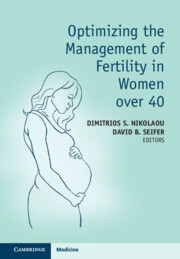Book contents
- Optimizing the Management of Fertility in Women over 40
- Optimizing the Management of Fertility in Women over 40
- Copyright page
- Dedication
- Contents
- Contributors
- Introduction
- Section 1 Demographic Trends
- Section 2 Biological Basis of Female Reproductive Aging: What Happens to the Ovaries and the Uterus as they Age?
- Section 3 Lifestyle, Environment, and Optimizing Reproduction in the 40s
- Section 4 Rethinking and Redefining “Family Planning” for the Twenty-First Century
- Section 5 Optimal Deployment of ART beyond 40
- Section 6 Obstetric Management beyond 40
- Chapter 10 Optimal Management of the First Trimester in Women over 40
- Chapter 11 Optimal Management of Pregnancy beyond 12 Weeks, Labour and the Puerperium for Women over 40
- Section 7 Children of Older Parents
- Section 8 What Are Realistic Alternatives to Conceiving with Autologous Eggs?
- Section 9 New Technologies
- Section 10 Ethics
- Index
- References
Chapter 11 - Optimal Management of Pregnancy beyond 12 Weeks, Labour and the Puerperium for Women over 40
from Section 6 - Obstetric Management beyond 40
Published online by Cambridge University Press: 15 September 2022
- Optimizing the Management of Fertility in Women over 40
- Optimizing the Management of Fertility in Women over 40
- Copyright page
- Dedication
- Contents
- Contributors
- Introduction
- Section 1 Demographic Trends
- Section 2 Biological Basis of Female Reproductive Aging: What Happens to the Ovaries and the Uterus as they Age?
- Section 3 Lifestyle, Environment, and Optimizing Reproduction in the 40s
- Section 4 Rethinking and Redefining “Family Planning” for the Twenty-First Century
- Section 5 Optimal Deployment of ART beyond 40
- Section 6 Obstetric Management beyond 40
- Chapter 10 Optimal Management of the First Trimester in Women over 40
- Chapter 11 Optimal Management of Pregnancy beyond 12 Weeks, Labour and the Puerperium for Women over 40
- Section 7 Children of Older Parents
- Section 8 What Are Realistic Alternatives to Conceiving with Autologous Eggs?
- Section 9 New Technologies
- Section 10 Ethics
- Index
- References
Summary
This chapter examines the risks of pregnancy for women over 40 and the strategies to optimize the management of pregnancy, labour and puerperium in this age group. In the UK, antenatal care is not usually any different at less than 40 years unless there are other confounding factors. Women at advanced age booking for pregnancy should have a thorough risk assessment to ascertain risk of hypertensive diseases of pregnancy and those at higher risk should be started on 75 mcg aspirin from 12 weeks till until 36 weeks Increased surveillance for GDM is not recommended in the UK based on age alone. However, it should be noted that AMA is associated with an increased background incidence of diabetes and it is our practice to offer a mini glucose tolerance test. Risk of venous thromboembolism should be assessed at booking and at each encounter. Serial growth scans with doppler studies are to be performed starting from 26-28 weeks of gestation in women more than 40 years. Induction of labour is recommended between 39 to 40 weeks when maternal age is more than 40 years. There is insufficient evidence to comment on the possible effect on perinatal mortality and rates of operative delivery from this intervention and this should be mentioned when counselling for induction of labour.
Keywords
- Type
- Chapter
- Information
- Optimizing the Management of Fertility in Women over 40 , pp. 131 - 140Publisher: Cambridge University PressPrint publication year: 2022



